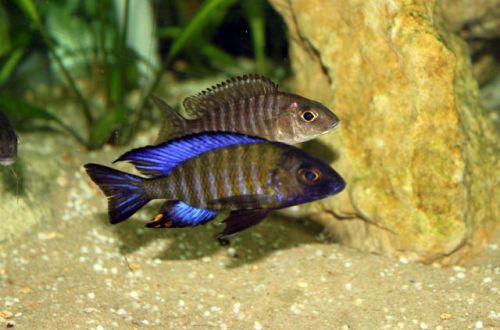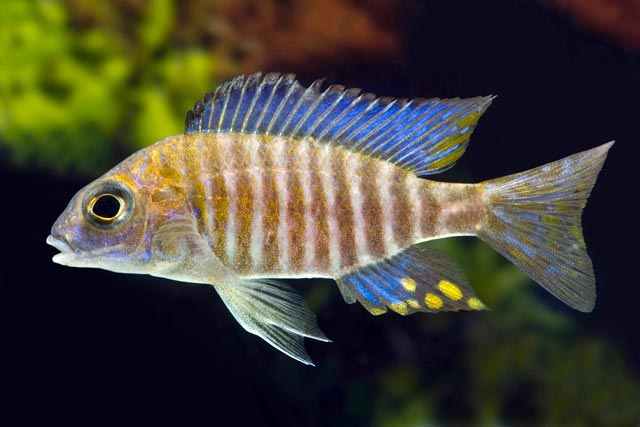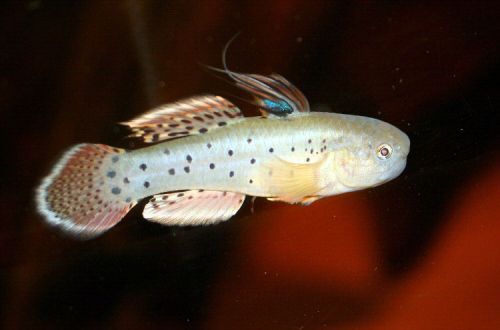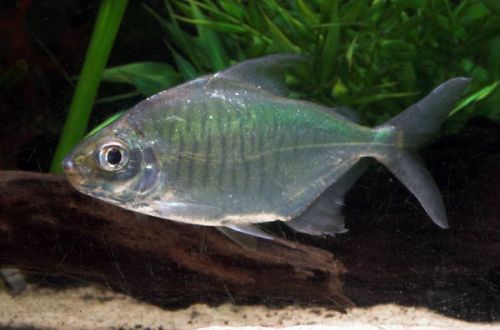
Northern Aulonocara
Aulonocara Ethelwyn or Northern Aulonocara, scientific name Aulonocara ethelwynnae, belongs to the Cichlidae family. A typical representative of cichlids from the African “Great Lakes”. Limited compatibility with relatives and other fish. Quite easy to keep and breed in the presence of a spacious aquarium.

Contents
Habitat
Endemic to Lake Malawi in Africa, found along the northwest coast. It inhabits the so-called intermediate zones, where rocky shores give way to a sandy bottom, with rocks scattered everywhere. Females and immature males live in groups in shallow water up to 3 meters deep, while adult males prefer to be alone at a depth (6–7 meters), forming their territory at the bottom.
Brief information:
- The volume of the aquarium – from 200 liters.
- Temperature – 22-26°C
- Value pH — 7.4–9.0
- Water hardness – 10–27 GH
- Substrate type – sandy
- Lighting – moderate
- Brackish water – no
- Water movement is weak
- The size of the fish is 7–8 cm.
- Food – small sinking food from a variety of products
- Temperament – conditionally peaceful
- Keeping in a harem with one male and several females
Description

Adult individuals reach a length of 9–11 cm. The color is dark gray with rows of barely visible vertical light stripes. Males are somewhat larger, the stripes may have blue tints, the fins and tail are blue. Females look less bright.
Food
They feed near the bottom, sifting sand through their mouths to filter out algae and small organisms. In a home aquarium, sinking foods containing herbal supplements, such as dry flakes, pellets, frozen brine shrimp, daphnia, bloodworm pieces, etc., should be fed. Food is fed in small portions 3-4 times a day.
Maintenance and care, arrangement of the aquarium
The minimum aquarium size for a group of 4-6 fish starts at 200 liters. The decoration is simple and includes a sandy substrate and heaps of large stones and rocks. It is worth remembering that large abrasive particles in the ground can get stuck in the mouth of the fish or damage the gills. In their natural habitat, aquatic plants are practically not found; in an aquarium, they will also be superfluous. In addition, the nutritional habit of the Northern Aulonocara does not allow the placement of rooted plants that will soon be dug up.
When keeping, it is important to ensure stable water conditions with suitable values of hydrochemical parameters. A productive and properly selected filtration system largely solves this problem. The filter must not only purify the water, but also resist the constant clogging of sand, the “clouds” of which are formed during the feeding of fish. Usually a combined system is used. The first filter carries out mechanical cleaning, retaining sand, and pumping water into the sump. From the sump, the water enters another filter that performs the rest of the purification steps and pumps the water back into the aquarium.
Behavior and Compatibility
Territorial adult males display aggressive behavior towards each other and similarly colored fish. Otherwise calm fish, able to get along well with other not too active species. The females are quite peaceful. Based on this, Aulonokara Ethelvin is recommended to be kept in a group consisting of one male and 4–5 females. Mbuna cichlids, due to their excessive mobility, are undesirable as tankmates.
Breeding / breeding
Successful breeding is possible only in a spacious aquarium from 400-500 liters in the presence of shelters in the form of crevices, grottoes. With the onset of the mating season, the male becomes overly persistent in his courtship. If the females are not ready, they are forced to hide in shelters. Comparative calmness will also provide them with being in a group of 4 or more individuals; in this situation, the attention of the male will be dispersed on several “targets”.
When the female is ready, she accepts the courtship of the male and lays several dozen eggs on some flat surface, such as a flat stone. After fertilization, he immediately takes them into his mouth. Further, the entire incubation period will take place in the mouth of the female. This offspring protection strategy is common to all Lake Malawi cichlids and is an evolutionary response to a highly competitive habitat.
The male does not participate in the care of offspring and begins to search for another companion.
The female carries the clutch for 4 weeks. It can be easily distinguished from others by the special “chewing” movement of the mouth, due to which it pumps water through the eggs, providing gas exchange. All this time the female does not eat.
Fish diseases
The main cause of diseases lies in the conditions of detention, if they go beyond the permissible range, then immunity suppression inevitably occurs and the fish becomes susceptible to various infections that are inevitably present in the environment. If the first suspicions arise that the fish is sick, the first step is to check the water parameters and the presence of dangerous concentrations of nitrogen cycle products. Restoration of normal/suitable conditions often promotes healing. However, in some cases, medical treatment is indispensable. Read more about symptoms and treatments in the Aquarium Fish Diseases section.





